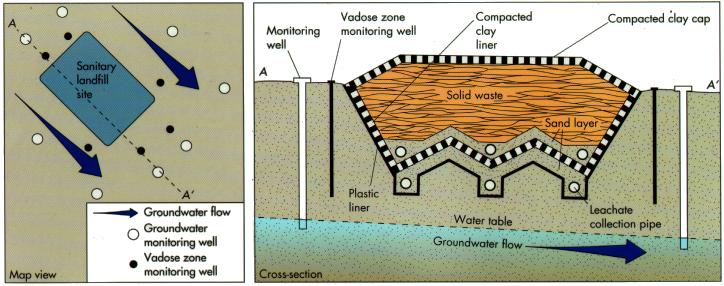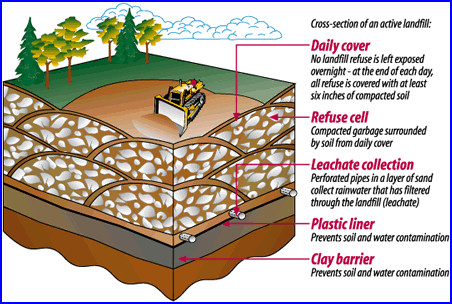A landfill, also known as a dump, rubbish dump or both, Rubbish Landfill Dump (and historically as a midden), is a site for the disposal of waste materials by burial and is the oldest form of waste treatment. Historically, landfills have been the most common methods of organized waste disposal and remain so in many places around the world.
Operations
Typically, in non hazardous waste landfills, in order to meet predefined specifications, techniques are applied by which the wastes are:
- Confined to as small an area as possible.
- Compacted to reduce their volume.
- Covered (usually daily) with layers of soil.
During landfill operations the waste collection vehicles are weighed at a weighbridge on arrival and their load is inspected for wastes that do not accord with the landfill’s waste acceptance criteria. Afterward, the waste collection vehicles use the existing road network on their way to the tipping face or working front where they unload their load. After loads are deposited, compactors or dozers are used to spread and compact the waste on the working face. Before leaving the landfill boundaries, the waste collection vehicles pass through the wheel cleaning facility. If necessary, they return to the weighbridge in order to be weighed without their load. Through the weighing process, the daily incoming waste tonnage can be calculated and listed in databases. In addition to trucks, some landfills may be equipped to handle railroad containers. The use of 'rail-haul' permits landfills to be located at more remote sites, without the problems associated with many truck trips.
Typically, in the working face, the compacted waste is covered with soil daily. Alternative waste-cover materials are several sprayed-on foam products and temporary blankets. Blankets can be lifted into place with tracked excavators and then removed the following day prior to waste placement. Chipped wood and chemically 'fixed' bio-solids may also be used as an alternate daily cover. The space that is occupied daily by the compacted waste and the cover material is called a daily cell. Waste compaction is critical to extending the life of the landfill. Factors such as waste compressibility, waste layer thickness and the number of passes of the compactor over the waste affect the waste densities.
Impacts
A large number of adverse impacts may occur from landfill operations. These impacts can vary: fatal accidents ( scavengers buried under waste piles);infastructure damage (e.g., damage to access roads by heavy vehicles); pollution of the local environment (such as contamination of groundwater and/or aquifers by leakage and residual soil contamination during landfill usage, as well as after landfill closure); offgassing of methane generated by decaying organic wastes (methane is a greenhouse gas many times more potent than carbon dioxide, and can itself be a danger to inhabitants of an area); harbouring of disease vectors such as rats and flies, particularly from improperly operated landfills, which are common in Third-World countries; injuries to wildlife; and simple nuisance problems (e.g., dust, odour, vermine, or noise pollutin).
Environmental noise and dust are generated from vehicles accessing a landfill as well as from working face operations. These impacts are best to intercept at the planning stage where access routes and landfill geometrics can be used to mitigate such issues. Vector control is also important, but can be managed reasonably well with the daily cover protocols.
Most modern landfills in industrialized countries are operated with controls to attempt to manage problems such as these. Analyses of common landfill operational problems are available.
Some local authorities have found it difficult to locate new landfills. Communities may charge a fee or levy in order to discourage waste and/or recover the costs of site operations. Many landfills are publicly funded, but some are commercial businesses, operated for profit.





Cooling towers are an essential element in any large scale industrial activity recently. Due to the growing need of cooling towers around the world and in India in particular, many companies have been set up to meet the demand of such towers in various industrial applications.
ReplyDelete